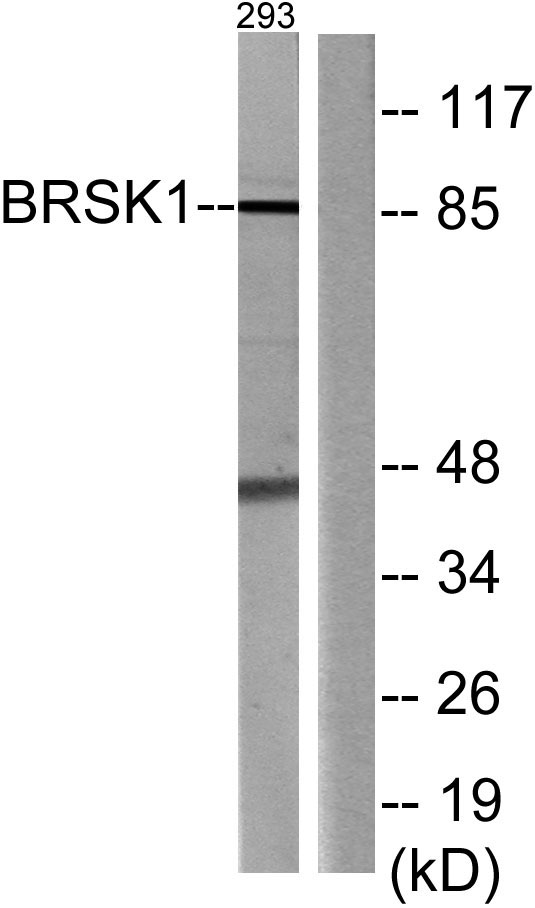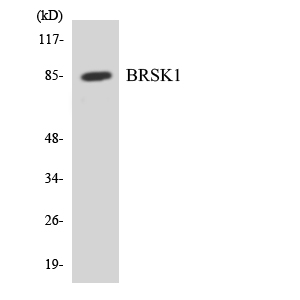BRSK1 Polyclonal Antibody
- Catalog No.:YT0535
- Applications:WB;IF;ELISA
- Reactivity:Human;Mouse
- Target:
- BRSK1
- Gene Name:
- BRSK1
- Protein Name:
- Serine/threonine-protein kinase BRSK1
- Human Gene Id:
- 84446
- Human Swiss Prot No:
- Q8TDC3
- Mouse Gene Id:
- 381979
- Mouse Swiss Prot No:
- Q5RJI5
- Immunogen:
- The antiserum was produced against synthesized peptide derived from human BRSK1. AA range:361-410
- Specificity:
- BRSK1 Polyclonal Antibody detects endogenous levels of BRSK1 protein.
- Formulation:
- Liquid in PBS containing 50% glycerol, 0.5% BSA and 0.02% sodium azide.
- Source:
- Polyclonal, Rabbit,IgG
- Dilution:
- WB 1:500 - 1:2000. IF 1:200 - 1:1000. ELISA: 1:5000. Not yet tested in other applications.
- Purification:
- The antibody was affinity-purified from rabbit antiserum by affinity-chromatography using epitope-specific immunogen.
- Concentration:
- 1 mg/ml
- Storage Stability:
- -15°C to -25°C/1 year(Do not lower than -25°C)
- Other Name:
- BRSK1;KIAA1811;SAD1;SADB;Serine/threonine-protein kinase BRSK1;Brain-selective kinase 1;Brain-specific serine/threonine-protein kinase 1;BR serine/threonine-protein kinase 1;Serine/threonine-protein kinase SAD-B;Synapses of Amphids
- Observed Band(KD):
- 87kD
- Background:
- catalytic activity:ATP + a protein = ADP + a phosphoprotein.,cofactor:Magnesium.,enzyme regulation:Activated by phosphorylation on Thr-205 by STK11 in complex with STE20-related adapter-alpha (STRAD alpha) pseudo kinase and CAB39.,function:Required for the polarization of forebrain neurons which endows axons and dendrites with distinct properties, possibly by locally regulating phosphorylation of microtubule-associated proteins (By similarity). May be involved in the regulation of G2/M arrest in response to UV- or methyl methane sulfonate (MMS)-induced, but not IR-induced, DNA damage. Phosphorylates WEE1 and CDC25B in vitro and CDC25C in vitro and in vivo.,similarity:Belongs to the protein kinase superfamily. CAMK Ser/Thr protein kinase family. AMPK subfamily.,similarity:Contains 1 protein kinase domain.,similarity:Contains 1 UBA domain.,subcellular location:Nuclear in the absence of DNA damage. Translocated to the nucleus in response to UV- or MMS-induced DNA damage.,tissue specificity:Widely expressed, with highest levels in brain and testis. Protein levels remain constant throughout the cell cycle.,
- Function:
- catalytic activity:ATP + a protein = ADP + a phosphoprotein.,cofactor:Magnesium.,enzyme regulation:Activated by phosphorylation on Thr-205 by STK11 in complex with STE20-related adapter-alpha (STRAD alpha) pseudo kinase and CAB39.,function:Required for the polarization of forebrain neurons which endows axons and dendrites with distinct properties, possibly by locally regulating phosphorylation of microtubule-associated proteins (By similarity). May be involved in the regulation of G2/M arrest in response to UV- or methyl methane sulfonate (MMS)-induced, but not IR-induced, DNA damage. Phosphorylates WEE1 and CDC25B in vitro and CDC25C in vitro and in vivo.,similarity:Belongs to the protein kinase superfamily. CAMK Ser/Thr protein kinase family. AMPK subfamily.,similarity:Contains 1 protein kinase domain.,similarity:Contains 1 UBA domain.,subcellular location:Nuclear in the absence of DNA
- Subcellular Location:
- Cytoplasm . Nucleus . Cytoplasm, cytoskeleton, microtubule organizing center, centrosome . Cell junction, synapse . Cell junction, synapse, presynaptic active zone . Cytoplasmic vesicle, secretory vesicle, synaptic vesicle . Nuclear in the absence of DNA damage. Translocated to the nucleus in response to UV- or MMS-induced DNA damage (By similarity). .
- Expression:
- Widely expressed, with highest levels in brain and testis. Protein levels remain constant throughout the cell cycle.
- June 19-2018
- WESTERN IMMUNOBLOTTING PROTOCOL
- June 19-2018
- IMMUNOHISTOCHEMISTRY-PARAFFIN PROTOCOL
- June 19-2018
- IMMUNOFLUORESCENCE PROTOCOL
- September 08-2020
- FLOW-CYTOMEYRT-PROTOCOL
- May 20-2022
- Cell-Based ELISA│解您多样本WB检测之困扰
- July 13-2018
- CELL-BASED-ELISA-PROTOCOL-FOR-ACETYL-PROTEIN
- July 13-2018
- CELL-BASED-ELISA-PROTOCOL-FOR-PHOSPHO-PROTEIN
- July 13-2018
- Antibody-FAQs
- Products Images

- Western Blot analysis of 293 cells using BRSK1 Polyclonal Antibody

- Western blot analysis of lysates from 293 cells, using BRSK1 Antibody. The lane on the right is blocked with the synthesized peptide.

- Western blot analysis of the lysates from COLO205 cells using BRSK1 antibody.



